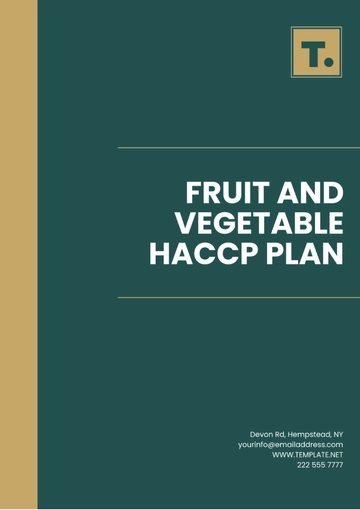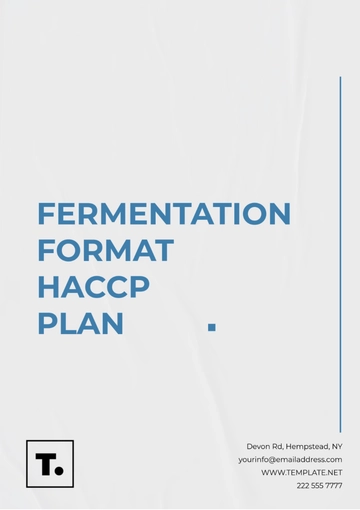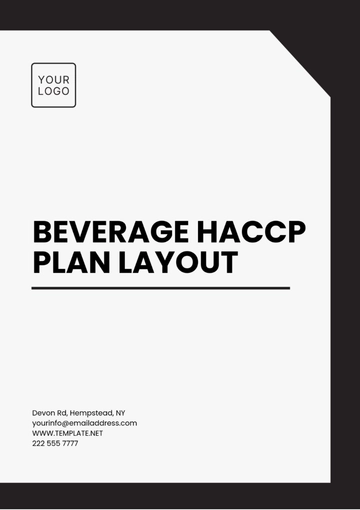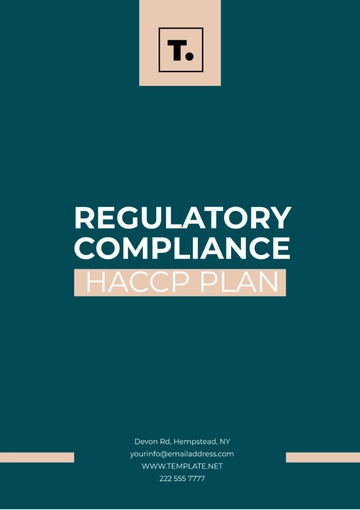Free Fruit And Vegetable HACCP Plan

Company Name: [YOUR COMPANY NAME]
Address: [YOUR COMPANY ADDRESS]
Contact Person: [YOUR NAME]
Date: June 12, 2050
I. Introduction
This HACCP plan ensures the safety of fruits and vegetables managed by [Your Company Name], outlining a systematic approach to identify, evaluate, and control food safety hazards at every production stage, from growing to consumption, and is vital for compliance with food safety regulations while demonstrating our commitment to providing safe, high-quality products to our customers.
II. Scope
This Hazard Analysis and Critical Control Points plan applies to every stage of the production process for the products listed as follows:
Fresh Fruits: e.g., apples, oranges, strawberries, bananas
Fresh Vegetables: e.g., lettuce, carrots, bell peppers, tomatoes
Processed Fruits and Vegetables: e.g., canned, frozen, dehydrated, and packaged products
III. Hazard Analysis
A thorough hazard analysis has been conducted to identify potential biological, chemical, and physical hazards associated with each product. Each identified hazard is evaluated based on its likelihood of occurrence and severity, guiding the establishment of effective control measures.
Product | Hazard Type | Description | Source/Notes |
|---|---|---|---|
Fresh Apples | Biological | Pathogenic bacteria (e.g., E. coli, Salmonella) | Contamination from soil or during handling |
Fresh Lettuce | Chemical | Pesticide residues | Improper use or application of pesticides |
Frozen Mixed Vegetables | Physical | Foreign objects (e.g., glass, metal shards) | Contamination during processing or packaging |
IV. Critical Control Points (CCPs)
CCPs are vital steps in food processing and handling where control measures can be applied to prevent, eliminate, or reduce food safety hazards to an acceptable level. The identification of these points is crucial for effective monitoring.
Process Step | CCP | Justification |
|---|---|---|
Washing Fruits | Yes | Effectively removes surface contaminants, ensuring fruits are safe for consumption. |
Cutting Vegetables | Yes | Prevents cross-contamination between raw and processed foods, maintaining food safety. |
Cooling Processed Products | Yes | Essential to minimize bacterial growth, particularly in high-risk products. |
V. Critical Limits
Critical limits define the maximum or minimum value to which a physical, biological, or chemical hazard must be controlled at a CCP to ensure food safety.
CCP | Critical Limit | Monitoring Frequency |
|---|---|---|
Washing Fruits | Water temperature ≥ 55°C | Every hour |
Cutting Vegetables | Clean cutting surfaces (sanitized after each use) | Before each use |
Cooling Processed Products | Temperature ≤ 4°C | Every 30 minutes |
VI. Monitoring Procedures
Effective monitoring procedures are essential to ensure that each CCP remains within its established critical limits. Monitoring will involve regular checks and documentation.
CCP | Monitoring Procedure | Frequency |
|---|---|---|
Washing Fruits | Measure and record water temperature; visually inspect for cleanliness. | Hourly |
Cutting Vegetables | Check and document the cleanliness of cutting surfaces before each use. | Before each use |
Cooling Processed Products | Use calibrated thermometers to measure and log product temperature. | Every 30 minutes |
VII. Corrective Actions
When monitoring indicates a deviation from a critical limit, specific corrective actions must be taken to address the issue and prevent recurrence.
CCP | Deviation | Corrective Action |
|---|---|---|
Washing Fruits | Water temperature < 55°C | Stop washing, reheat water, and retrain staff on procedures. |
Cutting Vegetables | Contaminated surface | Clean and sanitize the surface immediately; conduct retraining. |
Cooling Processed Products | Temperature > 4°C | Move products to a refrigeration unit and investigate the cause. Document the incident. |
VIII. Verification Procedures
Verification ensures that the HACCP plan is functioning effectively and that all procedures are being followed correctly.
Record Reviews: Conduct weekly reviews of monitoring logs and corrective action reports to ensure compliance.
Internal Audits: Perform quarterly internal audits of the HACCP plan, checking adherence to the established procedures.
Equipment Calibration: Verify that all monitoring equipment is calibrated correctly at least once a year.
IX. Record Keeping
Comprehensive records are vital for demonstrating compliance with food safety standards and tracking the effectiveness of the HACCP plan.
Monitoring Logs: Document all monitoring results for each CCP.
Corrective Action Reports: Maintain records of deviations and the actions taken.
Training Records: Document employee training and attendance.
Audit Reports: Store all internal and external audit findings.
X. Training
Employee training is crucial for ensuring that all personnel involved in food handling understand and adhere to food safety practices.
Initial Training: All employees must complete a HACCP training program before handling food products.
Ongoing Training: Provide refresher courses every six months to reinforce food safety principles and updates on best practices.
Specific Role Training: Employees with specific roles (e.g., monitoring CCPs) will receive additional targeted training.
- 100% Customizable, free editor
- Access 1 Million+ Templates, photo’s & graphics
- Download or share as a template
- Click and replace photos, graphics, text, backgrounds
- Resize, crop, AI write & more
- Access advanced editor
Manage food safety in your produce supply chain with the Fruit and Vegetable HACCP Plan Template from Template.net. This customizable, editable template helps you create a comprehensive plan for fruit and vegetable handling, from farm to table. With our Ai Editor Tool, you can easily adjust the template to suit your specific operational needs, ensuring regulatory compliance with HACCP standards.
You may also like
- Finance Plan
- Construction Plan
- Sales Plan
- Development Plan
- Career Plan
- Budget Plan
- HR Plan
- Education Plan
- Transition Plan
- Work Plan
- Training Plan
- Communication Plan
- Operation Plan
- Health And Safety Plan
- Strategy Plan
- Professional Development Plan
- Advertising Plan
- Risk Management Plan
- Restaurant Plan
- School Plan
- Nursing Home Patient Care Plan
- Nursing Care Plan
- Plan Event
- Startup Plan
- Social Media Plan
- Staffing Plan
- Annual Plan
- Content Plan
- Payment Plan
- Implementation Plan
- Hotel Plan
- Workout Plan
- Accounting Plan
- Campaign Plan
- Essay Plan
- 30 60 90 Day Plan
- Research Plan
- Recruitment Plan
- 90 Day Plan
- Quarterly Plan
- Emergency Plan
- 5 Year Plan
- Gym Plan
- Personal Plan
- IT and Software Plan
- Treatment Plan
- Real Estate Plan
- Law Firm Plan
- Healthcare Plan
- Improvement Plan
- Media Plan
- 5 Year Business Plan
- Learning Plan
- Marketing Campaign Plan
- Travel Agency Plan
- Cleaning Services Plan
- Interior Design Plan
- Performance Plan
- PR Plan
- Birth Plan
- Life Plan
- SEO Plan
- Disaster Recovery Plan
- Continuity Plan
- Launch Plan
- Legal Plan
- Behavior Plan
- Performance Improvement Plan
- Salon Plan
- Security Plan
- Security Management Plan
- Employee Development Plan
- Quality Plan
- Service Improvement Plan
- Growth Plan
- Incident Response Plan
- Basketball Plan
- Emergency Action Plan
- Product Launch Plan
- Spa Plan
- Employee Training Plan
- Data Analysis Plan
- Employee Action Plan
- Territory Plan
- Audit Plan
- Classroom Plan
- Activity Plan
- Parenting Plan
- Care Plan
- Project Execution Plan
- Exercise Plan
- Internship Plan
- Software Development Plan
- Continuous Improvement Plan
- Leave Plan
- 90 Day Sales Plan
- Advertising Agency Plan
- Employee Transition Plan
- Smart Action Plan
- Workplace Safety Plan
- Behavior Change Plan
- Contingency Plan
- Continuity of Operations Plan
- Health Plan
- Quality Control Plan
- Self Plan
- Sports Development Plan
- Change Management Plan
- Ecommerce Plan
- Personal Financial Plan
- Process Improvement Plan
- 30-60-90 Day Sales Plan
- Crisis Management Plan
- Engagement Plan
- Execution Plan
- Pandemic Plan
- Quality Assurance Plan
- Service Continuity Plan
- Agile Project Plan
- Fundraising Plan
- Job Transition Plan
- Asset Maintenance Plan
- Maintenance Plan
- Software Test Plan
- Staff Training and Development Plan
- 3 Year Plan
- Brand Activation Plan
- Release Plan
- Resource Plan
- Risk Mitigation Plan
- Teacher Plan
- 30 60 90 Day Plan for New Manager
- Food Safety Plan
- Food Truck Plan
- Hiring Plan
- Quality Management Plan
- Wellness Plan
- Behavior Intervention Plan
- Bonus Plan
- Investment Plan
- Maternity Leave Plan
- Pandemic Response Plan
- Succession Planning
- Coaching Plan
- Configuration Management Plan
- Remote Work Plan
- Self Care Plan
- Teaching Plan
- 100-Day Plan
- HACCP Plan
- Student Plan
- Sustainability Plan
- 30 60 90 Day Plan for Interview
- Access Plan
- Site Specific Safety Plan





























